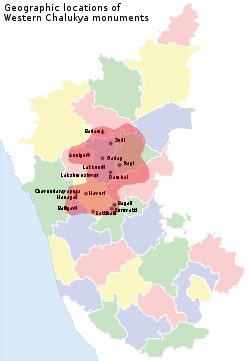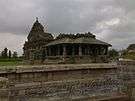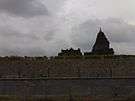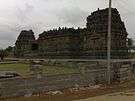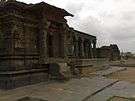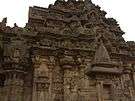Lakkundi
Lakkundi[1][2] in Gadag District of Karnataka is a tiny village on the way to Hampi (Hosapete) from Hubballi. Lakkundi 11 km from Gadag in the east. It is 14 km from Dambal and 25 km from Mahadeva Temple (Itagi).
Lakkundi Lakkigundi | |
|---|---|
town | |
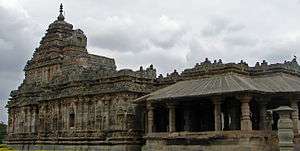 Brahma Jinalaya at Lakkundi | |
 Lakkundi Location in Karnataka, India  Lakkundi Lakkundi (India) | |
| Coordinates: 15°23′23″N 75°43′06″E | |
| Country | |
| State | Karnataka |
| Languages | |
| • Official | Kannada |
| Time zone | UTC+5:30 (IST) |
| ISO 3166 code | IN-KA |
| Vehicle registration | KA-26 |
| Nearest city | Gadag |
Lakkundi, is full of ruined temples[3] like Mallikarjuna, Virabhadra, Manikeshwara, Nanneshwara, Lakshminarayana, Someshwara, Nilakanteshwara and many more.
Lakkundi is a place of antiquarian interest with as many as 50 temples, 101 stepped wells (called Kalyani or Pushkarni) and 29 inscriptions, spread over the period of the later Chalukyas, Kalachuris, Seuna and the Hoysalas. A great center of Kalyani Chalukyas art, there are several temples of note here. Among them the Kasivisvesvara temple, Lakkundi is the most ornate and elaborately furnished. There is also the Brahma Jinalaya, a Jain temple, the largest and oldest shrine at Lakkundi. There is sculpture gallery (Museum) maintained by the ASI (Archaeological Survey of India).
Lakkundi also has a Darga of Zindeshah Wali.
History
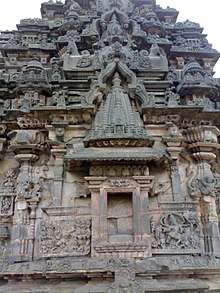
Lakkundi is known for the temple architecture and Danachintamani Attimabbe (patronage for Kannada literature and Jainism).
Other name for Lakkundi was called as LokkiGundi[4] in the inscriptions.
Lakkundi was ruled by later Chalukyas, Kalachuris, Seuna and the Hoysalas. The Chalukyas who wrested power from the Rashtrakutas (9th-10th centuries), made Kalyani their capital. Nothing remains of this city now. Most of the later Chalukya temples are preserved in Lakkundi. The Jain temple at Lakkundi near Gadag forms the next step in the development of Kalyani Chalukyas[5] style introducing a greater ornamental effect in the treatment of the surface.
In the 12th century, the Kalyani Chalukyas style of architecture reaches its maturity and culmination. Kasivisvesvara temple, Lakkundi, Mallikarjuna at Kuruvatii and Mahadeva Temple (Itagi) are the finest examples produced by the later Chalukya architects. The architecture of the Kalyani Chalukyas of Kalyani are said to be a link between those of the early Chalukyas of Badami and the Hoysalas who succeeded them.
Temples
At Lakkundi all the temples are made of green schist and the outer walls and entrances are very richly decorated. The shikhara is an in-between-style type and the parapet and the artistic division of the wall with pilasters is typical of the south-Indian style.
Currently Lakkundi has about 50 temples of various stature and antiquity. Some of the temples of note are Halagunda Basavanna Temple, Laxmianarayana Temple, Mallikarjuna Temple, Manikeshwara Temple, Nadayadeva Temple, Nagaradeva Shrine, Neelakanteshwara Temple, Suryanarayana Shrine (of Sun God facing the Kashi Vishweshwara Temple ), Someshwara Temple, Virabhadara Temple, Vishwantha Temple, Virupaksha Temple. Most of them are dedicated to Lord Siva and his various aspects.
Gadag, the district center itself have a few attractive temples. Trikuteshwara Shiva temple is impressive with its intricately ornate pillars, screens of carved stones and friezes.
Attimabbe
Attimabbe, known as Danachintamani is a well known personality of the Kalyani Chalukyas period. Attimabbe was the wife of Nagadeva who was the chieftain and soldier of Chalukya King Ahavamalla and mother of Ahniga Masavadi who was ruling Lakkundi for some time. Attimabbe sheltered the great poet Ranna. She made 1000 copies of poet Ponna's Santi purana and distributed as Sastradana. Attimabbe built a Jain temple at Lakkundi[6] to which the king (Satyashraya) provided a golden Kalasa.
Inscriptions
Lakkundi is also a treasure house of many important Inscriptions[7] (about 29).
- The inscriptions of the Kalyani Chalukyas king Irive Bedanga narrates in Ajithanatha Purana the details of the construction of the Brahmajinalaya by Attimabbe and the donations.
- The inscriptions of the Kalachuris of Kalyani King Sovideva (1173 A.D.) reveals the donation of gold to a Basadi by Gunanidi Keshava.
- The important inscriptions of Kalyani Chalukyas Somashekara VI (1185 A.D.), reveals the donation for conducting Ashtavidharchana. Another 12th-century inscription mentions the donation of land to Tribhuvana tilaka Shantinatha. Also an inscription mentions the existence of Jain saints Mulasangha Devanga.
Tourism
Lakkundi is known for the Chalukya style temples, stepped wells and historic inscriptions. Lakkundi is often a gem missed by majority of tourists.[8] One take the trouble of making visit to Lakkundi is rewarded with one of the fine architectural feasts of the Kalyana Chalukya period (c. 10th century CE).
Brahma Jinalaya (Adinath Basadi)
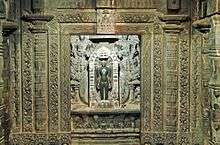
_Brahma_image_in_the_mantapa_in_the_Jain_temple_at_Lakkundi.jpg)
Brahma Jinalaya stands as the testimony of the high rank in the Karnataka temple Architecture. Brahma Jinalaya was built by queen Danachintamani Attimabbe is the largest of many Jain temples in Lakkundi. This Basadi is dedicated to Adinatha, the most revered saint of Jainism.
This Basadi is perhaps one of the earliest examples of temples in this area built of a kind of fine textured chloritic schist as distinct from the hitherto used sandstone of this region. The new material, because of its less thick quarry sizes and tractability, reacted on the workmanship, with the result that the masonry courses became reduced in size and the carvings more delicate and highly finished. The temple, perhaps built in the latter half of the 11th century, has a five-storeyed vimana, square on plan from the base to the shikhara, and had originally a closed square navaranga in front, though an open mandapawas added in front later on.
Basadi has a well fastened Mukha mantapa and open hall with central pillars decorated with beautiful carving. The Garbagudi holds the idol of Neminatha Tirthankara.
The central bay of the navaranga is a larger square than the peripheral eight around it. The second storey, as in the Jain temple at Pattadakal, is functional and has an antarala-mantapa in front over the vestibule of the lower storey. This raises the total height of the vimana considerably.
Kashivishvanatha Temple
Kashivishweshwara Temple, dedicated to Lord Shiva is meticulous for its carvings on the towers and the doorways. The heavy circular pillars were made using some kind of lathe.
A great deal of care has gone into the construction of the Kashivishvanatha temple in Lakkundi which deifies Shiva. This temple has a unique feature: a small surya shrine faces the main shrine on the west. There is a common platform between both which must have been an open mandapa originally. Hence the Kashivishvanatha temple has an entrance on the east side and south side of the mandapa. The entrance doorway and the towers are covered with close intricate carving. The shikhara is in the North-Indian style and it looks like a lathe must have been used to make the complex circular pillars.
Nanneshwara Temple
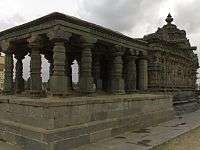
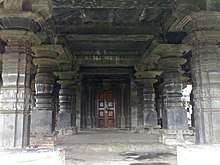
Nanneshwara Temple, located to its east, is worth a visit. This temple looks like a simple and small replica of the much elaborate Kashi Vishweshwara Temple. Probably the Nanneshwara Temple was built as a prototype before the grand Kashi Vishweshwara Temple was executed.
Stepped wells
Lakkundi is also noted for its step wells, artistically built with small canopied niches inside the walls of the wells enshrining lingas.
There are numerous ancient wells in Lakkundi, of which the Chateer Bavi, Kanne Bavi and Musukina Bavi are popular for their carvings architectural beauty. Most of the wells are carved with tiny Siva shrines in the form of niches into the walls.
Manikesvara Temple with Stepped Kalyani is one of the Tourist attractions of Lakkundi
At Lakkundi there is a stepped well of the Chalukya period next to the Manikeshwara temple.[9] On 3 sides of the Kalyani there are steps and the approach to the mandapa of the temples forms a bridge on the fourth side.
Weaving of Ambasi panje
Contrast bordered Lungi (Ambasi Phadiki Dhadi Panje) woven at Lakkundi,[10] the Dhoti (Lungi), daily wear woven with a contrast border using traditional motifs.
Transport
Lakkundi is well connected by road. It can be reached by coming to Gadag or Koppal. There are KSRTC buses from all over karnataka to Gadag and Koppal. It is 11 km from Gadag and 50 km from Koppal. The nearest Railway station is in Gadag city. Once you get dropped at the Lakkundi bus stand, you can practically cover all the temples and other monuments on foot. Nevertheless, you can hire a local taxi for better convenience. There are more than 15 Hindu and Jain temples in this town which was a prominent city a thousand years back.
Gallery
Photo Gallery |
|---|
|
See also
| Wikimedia Commons has media related to Lakkundi. |
|
|
Architecture References
- Western Chalukya architecture
- Hindu temple architecture
- Hoysala architecture
- Vijayanagara architecture
- Badami Chalukya architecture
- Dravidian architecture
References
- "Kalyani Chalukyan temples". Retrieved 20 August 2008.
- "A great tourist place i karanataka, Lakkundi". Retrieved 11 August 2008.
- "Chapter XIV, Karnataka, The Tourist Paradise". Archived from the original on 4 March 2009. Retrieved 3 March 2009.
- "CHAPTER 9. THE CALUKYAS AND THE KALACURYAS OF KALYANI. HISTORY–ANCIENT PERIOD, Chalukya" (PDF). Retrieved 10 March 2009.
- "The Chalukyas of Kalyani, Part 2". Retrieved 3 March 2009.
- "JAINA MONUMENTS IN NORTH KARNATAKA". By Dr. A. V. Narasimha Murthy. Archived from the original on 23 August 2009. Retrieved 3 March 2009.
- "LAKKUNDI". By Dr. A. V. Narasimha Murthy. Archived from the original on 6 January 2009. Retrieved 3 March 2009.
- "Handbook of Karnataka, Lakkundi". Archived from the original (PDF) on 16 February 2012. Retrieved 20 August 2008.
- "MANIKESVARA TEMPLE AND STEPPED TANK". Retrieved 3 March 2009.
- "Throw shuttle weaving of Ambasi panje (lungi)" (PDF). Retrieved 3 March 2009.
11. LAKKUNDIY BRAMAJINALAY : VASTU-SHILP-SHASAN (2014, Dr. Appanna N. Hanje, Vidyashre Prakashan, ALAGAWADI-591317 12. LAKKUNDIY BASADIGALU (2015), Dr. Appanna N. Hanje, Vidyashre Prakashan, ALAGAWADI-591317 13. SAMAVASARAN (Research Articles-2015), Dr. Appanna N. Hanje, Vidyashre Prakashan, ALAGAWADI-591317
